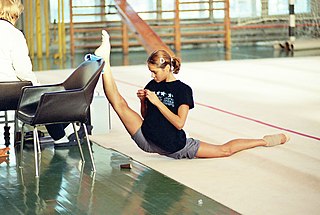 W
WPhysical fitness is a state of health and well-being and, more specifically, the ability to perform aspects of sports, occupations and daily activities. Physical fitness is generally achieved through proper nutrition, moderate-vigorous physical exercise, and sufficient rest.
 W
WAgility or nimbleness is an ability to change the body's position efficiently, and requires the integration of isolated movement skills using a combination of balance, coordination, speed, reflexes, strength and endurance. Agility is the ability to change the direction of the body in an efficient and effective manner and to achieve this requires a combination ofBalance – The ability to maintain equilibrium when stationary or moving through the coordinated actions of our sensory functions ; Static balance – The ability to retain the centre of mass above the base of support in a stationary position; Dynamic balance – The ability to maintain balance with body movement; Speed - The ability to move all or part of the body quickly; Strength - The ability of a muscle or muscle group to overcome a resistance; and lastly, Coordination – The ability to control the movement of the body in co-operation with the body's sensory functions.
 W
WBalance in biomechanics, is an ability to maintain the line of gravity of a body within the base of support with minimal postural sway. Sway is the horizontal movement of the centre of gravity even when a person is standing still. A certain amount of sway is essential and inevitable due to small perturbations within the body or from external triggers. An increase in sway is not necessarily an indicator of dysfunctional balance so much as it is an indicator of decreased sensorimotor control.
 W
WEndurance is the ability of an organism to exert itself and remain active for a long period of time, as well as its ability to resist, withstand, recover from, and have immunity to trauma, wounds, or fatigue. It is usually used in aerobic or anaerobic exercise. The definition of 'long' varies according to the type of exertion – minutes for high intensity anaerobic exercise, hours or days for low intensity aerobic exercise. Training for endurance can reduce the ability to exert endurance strength unless an individual also undertakes resistance training to counteract this effect.
 W
WFlexibility or limberness refers to the range of movement in a joint or series of joints, and length in muscles that cross the joints to induce a bending movement or motion. Flexibility varies between individuals, particularly in terms of differences in muscle length of multi-joint muscles. Flexibility in some joints can be increased to a certain degree by exercise, with stretching a common exercise component to maintain or improve flexibility.
 W
WMotor coordination is the combination of body movements created with the kinematic and kinetic (force) parameters that result in intended actions. Motor coordination is achieved when subsequent parts of the same movement, or the movements of several limbs or body parts are combined in a manner that is well timed, smooth, and efficient with respect to the intended goal. This involves the integration of proprioceptive information detailing the position and movement of the musculoskeletal system with the neural processes in the brain and spinal cord which control, plan, and relay motor commands. The cerebellum plays a critical role in this neural control of movement and damage to this part of the brain or its connecting structures and pathways results in impairment of coordination, known as ataxia.
 W
WPhysical activity is defined as any voluntary bodily movement produced by skeletal muscles that requires energy expenditure. Physical activity encompasses all activities, at any intensity, performed during any time of day or night. It includes exercise and incidental activity integrated into daily activity. This integrated activity may not be planned, structured, repetitive or purposeful for the improvement of fitness, and may include activities such as walking to the local shop, cleaning, working, active transport etc. Lack of physical activity is associated with a range of negative health outcomes whereas increased physical activity can improve physical as well as mental health. Physical activity increases energy expenditure and is a key regulator in controlling body weight.
 W
WPhysical strength is the measure of a human's exertion of force on physical objects. Increasing physical strength is the goal of strength training.